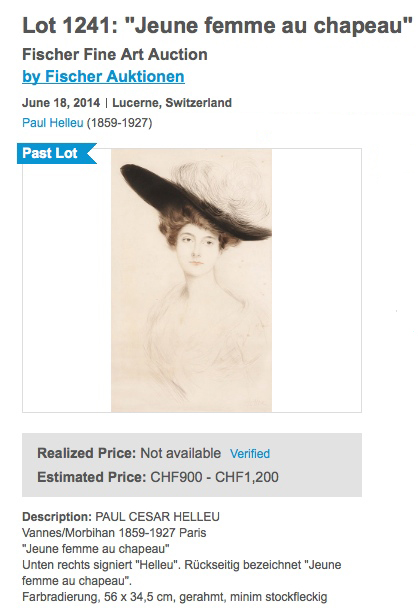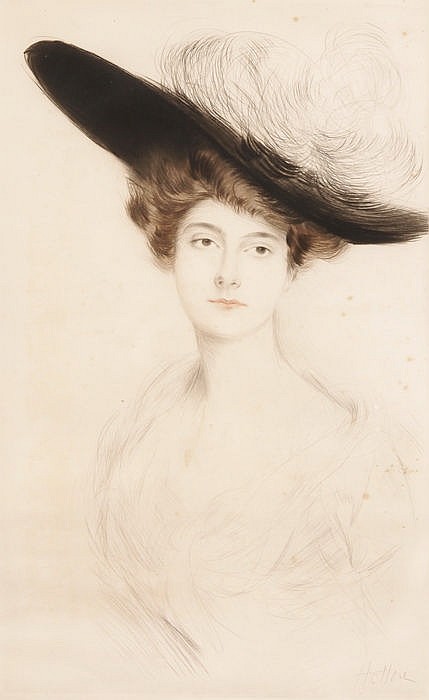A Helleu Acquisition§
writer: russell j.t. dyer; posted: October 30, 2014; revised: August 15, 2017; readers in past month: 1553
Earlier this year I purchased my first piece of original art for my home — I wrote about it in a previous post. I mentioned then that I bought a charcoal drawing through the site Invaluable.com. They host listings of art work for sale in art auctions around the world. I also mentioned that I want to acquire more art work. A month or so later I saw for sale on Invalualble.com some drypoint etchings by an artist named, Paul Cesar Helleu. He was an artist in Paris who lived from 1859 to 1927. He became famous for paintings, drawings, and drypoint etchings of beautiful, fashionable women of Paris at the time. In a way, he was the equivalent to a famous fashion photographer of our time.
A drypoint etching is made from a printing technique that was popular at the start of the 20th century. The artist engraves the mirror image of a picture onto a metal plate with a special hard-point needle, which is made with a metal or diamond tip. When he’s finished, the artist then would spread ink over the plate to fill in the incisions he made and then wipe away the excess ink. To prevent blotching, the artist would not dig very deep into the plate when engraving it so as not to have too much ink accumulate in the cracks. He would then use the inked plate to print the image on paper with a press. Helleu used this technique, and a couple of print shops in Paris that specialized in this type of printing, to make his etchings.
Since paintings and drawings by Helleu are one of a kind, they’re more valuable than his etchings. However, his etchings were not mass produced. Because of the type of material he used for the plates, probably copper, and the very shallow incisions he made, a plate would produce at most six prints, sometimes only four before it had to be discarded because it was too faint from the wiping away the excess ink and other aspects of the process. So although Helleu’s etchings are prints of sorts, they are very limited in number. This makes them more valuable than if he had somehow printed hundreds of copies of an image. After a hundred years, even if there were six to start, there may now be fewer of a particular image remaining due to prints being lost in fire and other accidents. This increases the value of the remaining ones. For some of his images, Helleu used more than one color of ink. He made fewer images with multiple colors since they were more work to produce. As a result, multiple color etchings are worth more.
As a person who likes to take photographs of beautiful women — as indicated in a previous post related to private lessons I took on studio photography — I appreciate very much Helleu’s works. They’re well done and the women he drew were beautiful. So when I discovered his etchings for sale on Invaluable.com, I quickly became interested in him and his works and knew I wanted to have one. I researched the artist and learned about his works. I’m not an expert on Helleu, but I’ve become familiar with the subject.
On the Invaluable.com web site, if you register, you can set up alerts to send you a message when art by a particular artist is listed in an auction. I created one for Helleu. At least once a month there is a Helleu picture listed somewhere. I watched the auctions to see how much they cost and then started to bid on them. I didn’t win the first few I bid on, though. I wasn’t yet willing to pay much for one of his etching. It wasn’t that I didn’t appreciate them. I just didn’t have the funds and daring to spend too much. In time, though, I became more interested in his etchings and decided I would not regret paying more for a Helleu, and that I would enjoy owning one.
In the early part of the summer, Fischer Galleries (an auction house in Luzern, Switzerland) listed a drypoint etching on the Invaluable.com site (see the screenshot at the top right). I liked this image very much and decided I wanted to try to get it. As you can see from the scanned copy of it on the right, it’s of a beautiful young woman wearing a hat (jeune femme au chapeau). She has an interesting pose, with a tranquil look on her face and such soft features, thinking so peacefully. It’s done with multiple colors, which is nice. It has some foxing — these are small spots believed to be an oxidation of the paper, but it’s not certain what causes them in very old paper — but not much foxing. It can be cleaned by a skilled restorer who knows how to do this kind of work.
Most of the auction houses use the site’s system to allow people to bid on art work. This works well. But this Swiss auction house used the site only to advertise the auction and the lots. To bid on a lot in this auction, you would have to either go to the auction in Luzern, or you would have to use an Absentee Bidder form to send in your maximum bid by email in advance. The auction house would bid on your behalf against bids from anyone present, but not to exceed your limit. I prefer to use the on-line bidding system, but since I wanted to try for this particular etching, I was willing to use the absentee bidding method. Plus, I figured that there may be fewer bidders because of this obstacle and I might thereby win the bid this time.
My assumption about the auction being sparse of Helleu bidders was correct. In fact, I was the only person who bid on it. At first, though, I didn’t get it. I called the auction house a few days after the auction to inquire about it. I was told by someone there that I didn’t win the bid because there was a minimum, starting bid that was two-hundred Swiss francs higher than my maximum bid. I was disappointed, but started considering bidding on other Helleu etchings elsewhere. Two days later, though, I received an invoice from the Swiss auction house for the Helleu. I called them and spoke this time with the manager. She told me that I had in fact won the bid, despite being under the minimum. I suspect that either the auction house or the owner of the picture decided that my low bid was better than not selling it.
I paid more than I had originally intended to pay for another art work like this. But I think I got it at a very good price. They valued it from 900 to 1,200 Swiss francs on the listing. At that time that was about 1,000 to 1,330 U.S. dollars. I paid a good bit less than 900 Swiss francs. However, I’ve since seen multiple color drypoint etchings by Helleu sell for over 2,000 and close to 3,000 dollars. So from a cost, as well as a value perspective, I was very happy about the purchase price.
It took me a couple of weeks to get the money together to send to the auction house. I wired it from my bank account in the U.S. since they wanted to be paid in Swiss francs and not euros. It was easier to do it from there: no need to convert dollars to euros and then to francs. By the time they received the money, they had closed for summer holidays. They didn’t ship it to me until August when they returned from vacation.
The etching arrived framed already, but it wasn’t a very nice frame. So I wanted to replace it with something better, something to match the color of my walls and to bring out the grandness of the etching. My friend Kristina Tool, who lives near me in Milan, is very good at determing things like this, the colors and styles appropriate to a room. She was visiting her mother in the U.S., so I waited for her to return in September to help me choose a frame. Then we were both busy, so it took a few weeks before we went to a frame shop to have it reframed.
Based on the color of my bedroom walls where I wanted to hang it and the look of picture, she recommended a wooden frame in silver, gold, or black, preferably with some sort of antique scrolling to it and wide to offset the narrowness of the proportions. We decided on a somewhat wide black frame, but had the shop add a gold and silver molding to the inner part of the frame. We looked at creme colored mats, but they made the picture look dirty. We found instead a gray-brown mat with a hint of rose to it. It took a week or two for the frame shop to make it, but this week I got it back. You can see a photo of it on the right. I think the frame is true to the elegant and antique nature of the piece. I’m very pleased with the results.
I’m thrilled that I managed to buy this Helleu. It’s hanging on a wall in my bedroom. Where it’s positioned, she seems to be looking out the window on the wall to her left. When I enter the room or pass by it, I hesitate for a moment and look at it and smile. It’s so serene; it makes me feel good to look at it.
I enjoy having it for its own sake, but since there are no more than six of this etching — actually, I searched the web and books and cannot find another like it, so it may be the last one — I feel privileged to be the keeper and protector of this one. I hope I won’t be its last protector and beneficiary; I hope it will continue on after I’m gone. More than that, this beautiful young woman existed. This artist existed. They came together about one hundred and fourteen years ago and created this art together. There was a personal connection between them and now I am part of their association in a very personal way. The results are in my home: this picture makes it feel more like a home.


